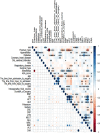Establishment and validation of clinical prediction model and prognosis of perioperative pneumonia in elderly patients with hip fracture complicated with preoperative acute heart failure
- PMID: 39567977
- PMCID: PMC11577948
- DOI: 10.1186/s12893-024-02668-w
Establishment and validation of clinical prediction model and prognosis of perioperative pneumonia in elderly patients with hip fracture complicated with preoperative acute heart failure
Abstract
Background: Elderly hip fracture was a common orthopedic emergency with high perioperative complication risks. Combined with preoperative acute heart failure, the risk increases further, with pneumonia being a common complication. The aim of this study was to construct and evaluate risk factor prediction models for perioperative pneumonia in these patients and to explore prognostic factors.
Methods: A retrospective study design was used to collect data on elderly patients with hip fracture combined with preoperative acute heart failure at the Third Hospital of Hebei Medical University from January 2020 to December 2022. The feature variables were screened by logistic regression and nomogram was constructed. The receiver operating characteristics curve (ROC), decision curve analysis (DCA), and calibration curve were employed to assess the predictive power of the model. Correlation heatmaps and shapley additive explanation (SHAP) were employed to assess key variables and their impact. Employing the Kaplan-Meier curve and Cox regression, the patients' prognosis was ultimately evaluated.
Results: 535 elderly patients with hip fracture combined with preoperative acute heart failure were included in this study. Logistic regression analysis was used to identify combined respiratory disease, hemoglobin, albumin, neutrophils, and blood glucose as independent danger factors for perioperative pneumonia (p < 0.05). The nomogram was designed to display the outcomes instinctively, with an AUC of 0.819. The model was internally validated by initiating self-sampling 1000 times. The calibration curve indicated that the model had excellent treaty. The DCA curve showed that the model had good validity and clinical practicability. Correlation heatmaps and SHAP were visualized and analyzed. The K-M curves indicated that the prognosis of the non-pneumonia group was better than that of the pneumonia group (p = 0.014). COX regression analysis found that the major risk factors for all-cause mortality in patients with acute heart failure(AHF) were age, brain natriuretic peptide, platelet count, and combined respiratory failure (p < 0.05).
Conclusion: The prediction model, established in this study, was highly accurate and proved a potent instrument for clinical evaluation of the perioperative pneumonia risk of elderly hip fracture patients with preoperative acute heart failure. We hope that this study can reduce the occurrence of perioperative pneumonia in patients and improve the prognosis of patients.
Keywords: Acute heart failure; Clinical prediction model; Elderly hip fracture; Perioperative pneumonia; Prognosis.
© 2024. The Author(s).
Conflict of interest statement
Declarations. Ethics approval and consent to participate: Prior to conducting the study, ethical approval was obtained from the Ethics Committee of the Third Hospital of Hebei Medical University (N0.2024-032-1). All methods are carried out in accordance with the relevant guidelines and regulations of the Declaration of Helsinki. Consent for publication: Not applicable. Competing interests: The authors declare no competing interests.
Figures






Similar articles
-
[Construction and validation of a nomogram for predicting in-hospital postoperative heart failure in elderly patients with hip fracture].Beijing Da Xue Xue Bao Yi Xue Ban. 2024 Oct 18;56(5):874-883. doi: 10.19723/j.issn.1671-167X.2024.05.019. Beijing Da Xue Xue Bao Yi Xue Ban. 2024. PMID: 39397468 Free PMC article. Chinese.
-
Developing a prediction model for preoperative acute heart failure in elderly hip fracture patients: a retrospective analysis.BMC Musculoskelet Disord. 2024 Sep 14;25(1):736. doi: 10.1186/s12891-024-07843-x. BMC Musculoskelet Disord. 2024. PMID: 39277727 Free PMC article.
-
Risk factors and characteristics of preoperative heart failure in elderly patients with hip fracture and the influence of anemia on prognosis.BMC Musculoskelet Disord. 2025 Jan 2;26(1):6. doi: 10.1186/s12891-024-08252-w. BMC Musculoskelet Disord. 2025. PMID: 39748385 Free PMC article.
-
Examination of factors causing postoperative pneumonia in elderly hip fracture patients: A narrative review.Medicine (Baltimore). 2025 Feb 28;104(9):e41700. doi: 10.1097/MD.0000000000041700. Medicine (Baltimore). 2025. PMID: 40020120 Free PMC article. Review.
-
Perioperative Focused Transthoracic Echocardiogram Evaluations for Elderly Hip Fractures: A Narrative Review of Literature and Recommendations.A A Pract. 2025 Mar 18;19(3):e01944. doi: 10.1213/XAA.0000000000001944. eCollection 2025 Mar 1. A A Pract. 2025. PMID: 40099817 Review.
References
-
- Sing CW, Lin TC, Bartholomew S, Bell JS, Bennett C, Beyene K, Bosco-Levy P, Bradbury BD, Chan AHY, Chandran M, et al. Global epidemiology of hip fractures: secular trends in Incidence Rate, Post-fracture Treatment, and all-cause mortality. J Bone Min Res. 2023;38(8):1064–75. - PubMed
-
- LeBlanc KE, Muncie HL Jr., LeBlanc LL. Hip fracture: diagnosis, treatment, and secondary prevention. Am Fam Physician. 2014;89(12):945–51. - PubMed
-
- Mir T, Uddin M, Qureshi WT, Shanah L, Soubani A, Saydain G, Afonso L, Mujeeb S. Trends and complications associated with acute new-onset heart failure: a National readmissions database-based cohort study. Heart Fail Rev. 2022;27(2):399–406. - PubMed
Publication types
MeSH terms
LinkOut - more resources
Full Text Sources
Medical

